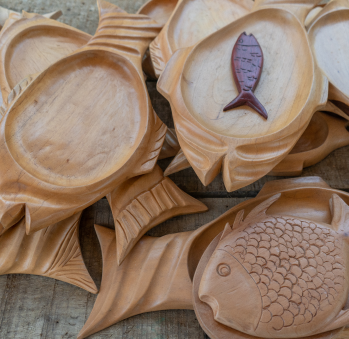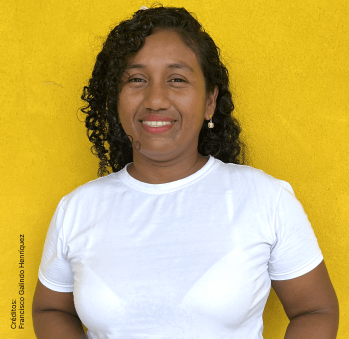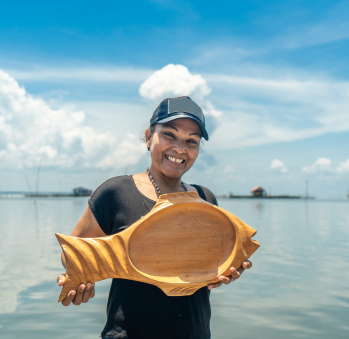Cindy Fernández y Beatriz Ariza
Workshop: Artesanos de la Ciénaga Grande
Craft: Trabajos en madera
Trail: Magdalena Route
Location: Pueblo Viejo, Magdalena
“Cindy Fernández and Beatriz Ariza talk on behalf of their fellow women carvers from Tasajera. Because all of them, with incredibly small variations, have the same story: being daughters of or coming from the fishing tradition of this Cienaguero town and having been enticed, all of them, to learn woodcarving, a trade that was reserved exclusively for men until they arrived. Moreover, it needs to be said, they managed to learn the trade in a meteoric way and saw themselves able to handle the tools they were afraid from after only a year spent among knives, burins, and polishers.
That day in September 2021 when the workshop in woodcarving was announced in town seems already far away to them. This group of women stopped by and, even though they had heard that it was aimed at carpenters who had already mastered the trade and wanted to perfect it, raised their hands saying that they wanted to learn. Being such a difficult job due to the physical demands it has, it was very unusual to see women apply for these calls. Nonetheless, teacher Neil Castro saw the will in them and that was enough for him to take a wager on them. He told the course’s organizers that he would give the “seños” some basic instructions to see if they had the knack for it. And they did.
Tasajera is right beside wáter: it is a small patch of land between fresh and salty waters. So, the fathers of these women, as of many other members of this community, were fishers. Cindy says that her father arrived from his marine incursions with battered feet and hurt fingernails, but that it was his life and he loved it. He had to regretfully give up that life selling his boat because it was no longer so easy to take care of it after growing old and moving: the boat constantly got loose with the breeze and it was no longer close enough to where he lived for him to be able to go and retrieve it. Beatriz remembers his shrimp-catching father, business that she inherited after his death. Likewise, she sees herself when she was young and went with him to repair the boat, the one that he called La Luz del Mundo (Light of the World.) She knows she made the promise that she would one day learn how to fix it herself.
That is the reason why they felt encouraged, already having lived half of their lives, to venture into their town’s woodworking tradition. Because, as they tell, every man from this community picks up a piece of wood and, without noticing his great skill, makes marvels with it. Regardless, they still see it as a useful object: for them it is a matter of repairing boats. So, it is these women who are giving the raw material that surrounds them the decorative and artisanal character with which they are now starting to stand out.
Cindy laughs of when she started out handling wood. She told her husband to come with her and help her with everything. She was terrified of the tools, to the point that she messed up two knives out of nervousness, and she also saw when Beatriz hit her finger with a hammer. Today, they are both very skillful working the caladoras and they even beat some carpenters that claim to be unable to polish by machine and that they would rather do so by hand. For them, a cut on the hands with the burin is part of the job and they and their partners have their first carving hanging proudly on the walls of their home. Beatriz fills up with pride because of the heron she made that encouraged her friends to get into this life-changing deal. Cindy sees with hopeful eyes that her daughter is getting involved in the trade because it can become a craft that gets perpetuated in the family.
Today, they are starting to go to artisanal fairs. And, although their masters have sent them because they know that they can already speak of shipwrecked woods that come cured by sun and rain, of how cedar wood is softer than caracolí, of making dyes from turmeric; they know that they are new to the trade and look with admiration to the Wayúu and San Jacinto weavers to whom they wish to compare in a couple of years. They know they are on the right track because they no longer fear the tools: they have become their friends, and nothing will ever separate them. “
Craft






Artisans along the way
Artisans along the way
No puede copiar contenido de esta página

































































